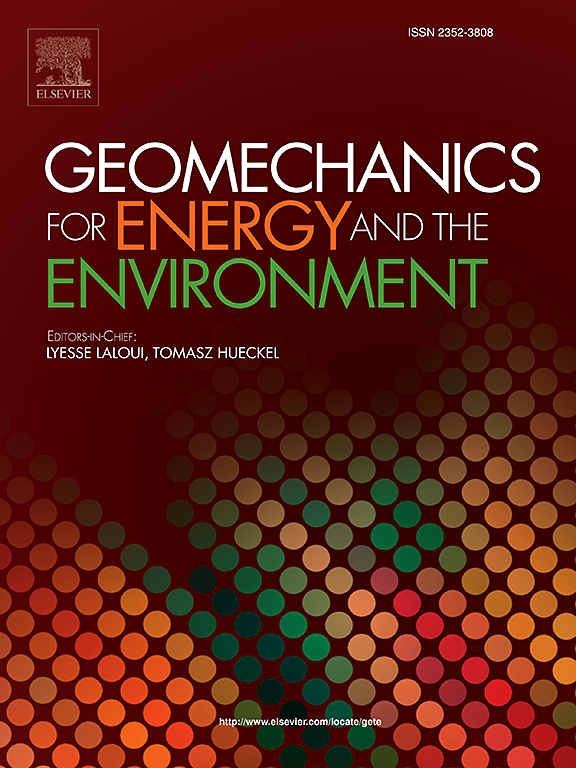Hybrid framework for surrogate modelling of massive solar collectors in road pavements
IF 3.3
2区 工程技术
Q3 ENERGY & FUELS
引用次数: 0
Abstract
This paper investigates the application of surrogate modelling in the design and thermal response assessment of Pavement Solar Collectors (PSCs). The PSC system is a sustainable infrastructure solution that utilises both solar and shallow geothermal energy. PSCs incorporate a network of pipes embedded in the asphalt layer to create a heat exchange layer. During warm months, water circulating through this layer captures solar heat, which can then be used for snow melting in winter, enhancing road safety, or for domestic and industrial heating applications. Finite Element (FE) analysis is a widely used method for evaluating the thermal response of PSCs to optimize their design. However, the substantial computational requirements of numerical modelling, especially for long-term time-dependent analyses, pose significant challenges in assessing the long-term thermal behaviour of PSCs. Surrogate models, approximating complex physics-based simulations, drastically reduce computational demands, enabling rapid and accurate evaluations of various design parameters and scenarios. In this study, a validated FE simulation framework was employed to generate data, which was then used to develop a data-driven surrogate model for PSCs. In order to refine the surrogate model's performance to its optimal level, hyperparameter optimisation was carried out. The comparison of outlet water temperature results between finite element and surrogate models showed a high correlation, with a coefficient of determination of 0.97 observed for both training and test data sets. Subsequently, the surrogate model was integrated as an objective function in a Particle Swarm Optimization (PSO) algorithm to automate the Heat Harvesting Capacity (HHC) optimisation of PSCs. The PSO algorithm demonstrates robust performance in identifying optimal solutions while also offering a substantial reduction in computational costs compared to FE simulations.
道路路面大规模太阳能集热器替代模型的混合框架
研究了替代模型在路面太阳能集热器(PSCs)设计和热响应评估中的应用。PSC系统是一个可持续的基础设施解决方案,利用太阳能和浅层地热能源。psc在沥青层中嵌入了一个管道网络,以形成一个热交换层。在温暖的月份,通过这一层循环的水捕获太阳热量,然后可用于冬季融雪,加强道路安全,或用于家庭和工业供暖。有限元分析是一种广泛使用的热响应评估方法,用于优化设计。然而,数值模拟的大量计算需求,特别是长期时间依赖分析,对评估psc的长期热行为提出了重大挑战。替代模型,近似复杂的基于物理的模拟,大大减少了计算需求,能够快速准确地评估各种设计参数和场景。在本研究中,采用一个经过验证的有限元模拟框架来生成数据,然后将其用于开发数据驱动的psc代理模型。为了使代理模型的性能达到最优水平,进行了超参数优化。有限元模型与代理模型的出水温度结果比较显示出较高的相关性,训练数据集与测试数据集的决定系数均为0.97。随后,将代理模型作为目标函数集成到粒子群优化(PSO)算法中,实现PSCs集热能力(HHC)的自动优化。与FE模拟相比,PSO算法在识别最优解方面表现出强大的性能,同时也大大降低了计算成本。
本文章由计算机程序翻译,如有差异,请以英文原文为准。
求助全文
约1分钟内获得全文
求助全文
来源期刊

Geomechanics for Energy and the Environment
Earth and Planetary Sciences-Geotechnical Engineering and Engineering Geology
CiteScore
5.90
自引率
11.80%
发文量
87
期刊介绍:
The aim of the Journal is to publish research results of the highest quality and of lasting importance on the subject of geomechanics, with the focus on applications to geological energy production and storage, and the interaction of soils and rocks with the natural and engineered environment. Special attention is given to concepts and developments of new energy geotechnologies that comprise intrinsic mechanisms protecting the environment against a potential engineering induced damage, hence warranting sustainable usage of energy resources.
The scope of the journal is broad, including fundamental concepts in geomechanics and mechanics of porous media, the experiments and analysis of novel phenomena and applications. Of special interest are issues resulting from coupling of particular physics, chemistry and biology of external forcings, as well as of pore fluid/gas and minerals to the solid mechanics of the medium skeleton and pore fluid mechanics. The multi-scale and inter-scale interactions between the phenomena and the behavior representations are also of particular interest. Contributions to general theoretical approach to these issues, but of potential reference to geomechanics in its context of energy and the environment are also most welcome.
 求助内容:
求助内容: 应助结果提醒方式:
应助结果提醒方式:


